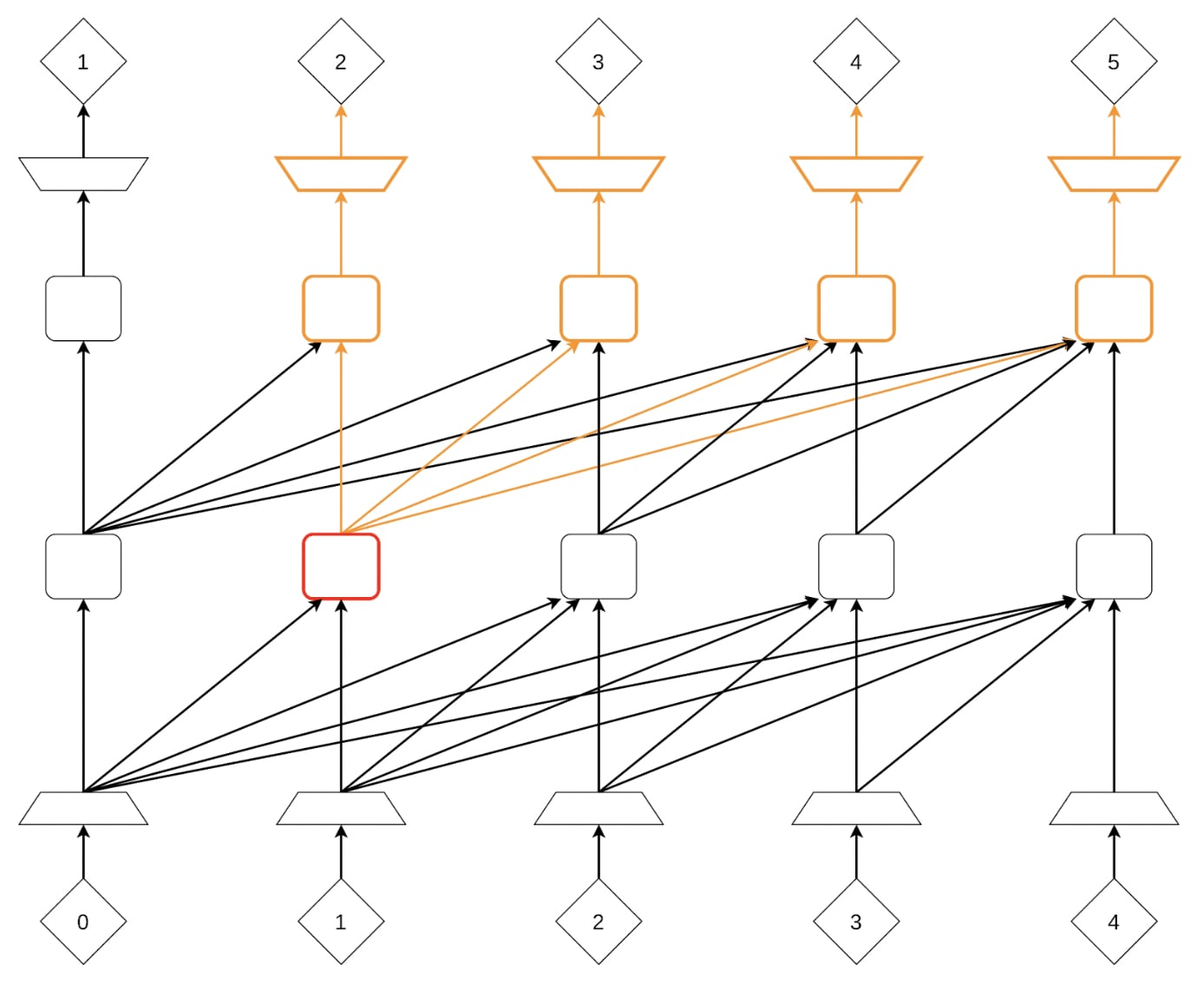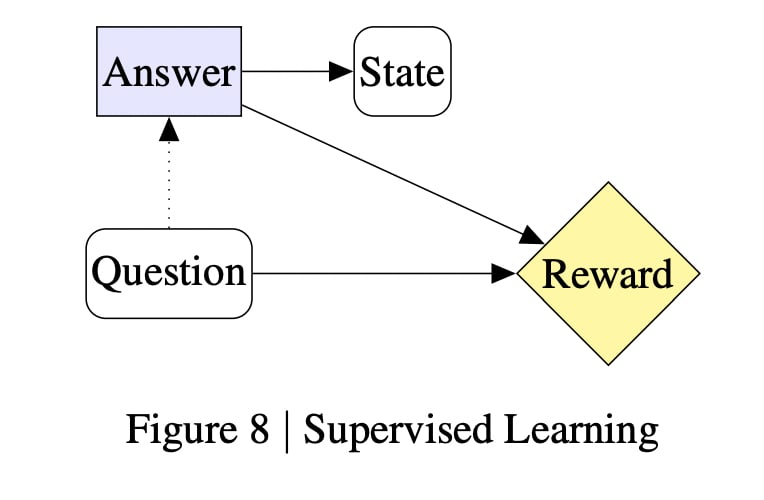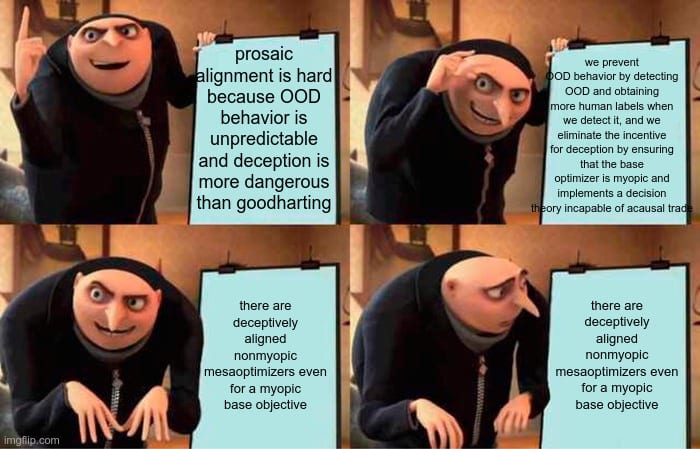How LLMs are and are not myopic
10Caspar Oesterheld
10Trinley Goldenberg
11Sheikh Abdur Raheem Ali
3Trinley Goldenberg
13janus
3cfoster0
1Phil Blandfort
5David Scott Krueger (formerly: capybaralet)
10Caspar Oesterheld
3David Johnston
3veered
2Sodium
2tailcalled
1Sheikh Abdur Raheem Ali
1AhmedNeedsATherapist
0Review Bot
New Comment
Here's a simple toy model that illustrates the difference between 2 and 3 (that doesn't talk about attention layers, etc.).
Say you have a bunch of triplets . Your want to train a model that predicts from and from .
Your model consists of three components: . It makes predictions as follows:
(Why have such a model? Why not have two completely separate models, one for predicting and one for predicting ? Because it might be more efficient to use a single both for predicting and for predicting , given that both predictions presumably require "interpreting" .)
So, intuitively, it first builds an "inner representation" (embedding) of . Then it sequentially makes predictions based on that inner representation.
Now you train and to minimize the prediction loss on the parts of the triplets. Simultaneously you train to minimize prediction loss on the full triplets. For example, you update and with the gradients
and you update and with the gradients
.
(The here is the "true" , not one generated by the model itself.)
This training pressures to be myopic in the second and third sense described in the post. In fact, even if we were to train with the predicted by rather than the true , is pressured to be myopic.
- Type 3 myopia: Training doesn't pressure to output something that makes the follow an easier-to-predict (computationally or information-theoretically) distribution. For example, imagine that on the training data implies , while under , follows some distribution that depends in complicated ways on . Then will not try to predict more often.
- Type 2 myopia: won't try to provide useful information to in its output, even if it could. For example, imagine that the s are strings representing real numbers. Imagine that is always a natural number, that is the -th Fibonacci number and is the -th Fibonacci number. Imagine further that the model representing is large enough to compute the -th Fibonacci number, while the model representing is not. Then one way in which one might think one could achieve low predictive loss would be for to output the -th Fibonacci number and then encode, for example, the -th Fibonacci number in the decimal digits. (E.g., .) And then computes the -th Fibonacci number from the -th decimal. But the above training will not give rise to this strategy, because gets the true as input, not the one produced by . Further, even if we were to change this, there would still be pressure against this strategy because () is not optimized to give useful information to . (The gradient used to update doesn't consider the loss on predicting .) If it ever follows the policy of encoding information in the decimal digits, it will quickly learn to remove that information to get higher prediction accuracy on .
Of course, still won't be pressured to be type-1-myopic. If predicting requires predicting , then will be trained to predict ("plan") .
(Obviously, $g_2$ is pressured to be myopic in this simple model.)
Now what about ? Well, is optimized both to enable predicting from and predicting from . Therefore, if resources are relevantly constrained in some way (e.g., the model computing is small, or the output of is forced to be small), will sometimes sacrifice performance on one to improve performance on the other. So, adapting a paragraph from the post: The trained model for (and thus in some sense the overall model) can and will sacrifice accuracy on to achieve better accuracy on . In particular, we should expect trained models to find an efficient tradeoff between accuracy on and accuracy on . When is relatively easy to predict, will spend most of its computation budget on predicting .
So, is not "Type 2" myopic. Or perhaps put differently: The calculations going into predicting aren't optimized purely for predicting .
However, is still "Type 3" myopic. Because the prediction made by isn't fed (in training) as an input to or the loss, there's no pressure towards making influence the output of in a way that has anything to do with . (In contrast to the myopia of , this really does hinge on not using in training. If mattered in training, then there would be pressure for to trick into performing calculations that are useful for predicting . Unless you use stop-gradients...)
* This comes with all the usual caveats of course. In principle, the inductive bias may favor a situationally aware model that is extremely non-myopic in some sense.
In my experience, larger models often become aware that they are a LLM generating text rather than predicting an existing distribution. This is possible because generated text drifts off distribution and can be distinguished from text in the training corpus.
I'm quite skeptical of this claim on face value, and would love to see examples.
I'd be very surprised if current models, absent the default prompts telling them they are an LLM, would spontaneously output text predicting they are an LLM unless steered in that direction.
I can vouch that I have had the same experience (but am not allowed to share outputs of the larger model I have in mind). First encountered via curation without intentional steering in that direction, but I would be surprised if this failed to replicate with an experimental setup that selects completions randomly without human input. Let me know if you have such a setup in mind that you feel is sufficiently rigorous to act as a crux.
Many users of base models have noticed this phenomenon, and my SERI MATS stream is currently working on empirically measuring it / compiling anecdotal evidence / writing up speculation concerning the mechanism.
It would definitely move the needle for me if y'all are able to show this behavior arising in base models without forcing, in a reproducible way.
Do you have any update on this? It goes strongly against my current understanding of how LLMs learn. In particular, in the supervised learning phase any output text claiming to be an LLM would be penalized unless such statements are included in the training corpus. If such behavior nevertheless arises I would be super excited to analyze this further though.
This means that the model can and will implicitly sacrifice next-token prediction accuracy for long horizon prediction accuracy.
Are you claiming this would happen even given infinite capacity?
If so, can you perhaps provide a simple+intuitive+concrete example?
This means that the model can and will implicitly sacrifice next-token prediction accuracy for long horizon prediction accuracy.
Are you claiming this would happen even given infinite capacity?
I think that janus isn't claiming this and I also think it isn't true. I think it's all about capacity constraints. The claim as I understand it is that there are some intermediate computations that are optimized both for predicting the next token and for predicting the 20th token and that therefore have to prioritize between these different predictions.
I can't speak for janus, but my interpretation was that this is due to a capacity budget meaning it can be favourable to lose a bit of accuracy on token n if you gain more on n+m. I agree som examples would be great.
In a causal-masked transformer, attention layers can query the previous layers' activations from any column in the context window. Gradients flow through the attention connections, so each previous layer is optimized not just to improve prediction accuracy for the next token, but also to produce values that are useful for future columns to attend to when predicting their token.
I think this is part of the reason why prompt engineering is so fiddly.
GPT essentially does a limited form of branch prediction and speculative execution. It guesses (based on the tokens evaluated so far) what pre-computation will be useful for future token predictions. If its guess is wrong, the pre-computation will be useless.
Prompts lets you sharpen the superposition of simulacra before getting to the input text, improving the quality of the branch prediction. However, the exact way that the prompt narrows down the simulacra can be pretty arbitrary so it requires lots of random experimentation to get right.
Ideally, at the end of the prompt the implicit superposition of simulacra should match your expected probability distribution over simulacra that generated your input text. The better the match, the more accurate the branch prediction and speculative execution will be.
But you can't explicitly control the superposition and you don't really know the distribution of your input text so... fiddly.
It is possible to modify the transformer architecture to enforce value (prediction accuracy) myopia by placing stop gradients in the attention layers. This effectively prevents past activations from being directly optimized to be more useful for future computation.
I think that enforcing this constraint might make interpretability easier. The pre-computation that transformers do is indirect, limited, and strange. Each column only has access to the non-masked columns of the previous residual block, rather than access to the non-masked columns of all residual blocks or even just access to the non-masked columns of all previous residual blocks.
Maybe RNNs like RWKV with full hidden state access are easier to interpret?
A consequence-blind simulator that predicts power-seeking agents (like humans) will still predict actions which seek power, but these actions will seek power for the simulated agent, not the simulator itself. I usually think about problems like this as simulator vs simulacra alignment. If you successfully build an inner aligned simulator, you can use it to faithfully simulate according to the rules it learns and generalizes from its training distribution. However you are still left with the problem of extracting consistently aligned simulacra.
Agreed. Gwern's short story "It Looks Like You’re Trying To Take Over The World" sketches a takeover scenario by a simulacrum.
This is concerning because it's not at all clear what a model that is predicting itself should output. It breaks many of the intuitions of why it should be safe to use LLMs as simulators of text distributions.
Doesn't Anthropic's Constitutional AI approach do something similar? They might be familiar with the consequences from their work on Claude.
Now that o1 explicitly does RL on CoT, next token prediction for o1 is definitely not consequence blind. The next token it predicts enters into its input and can be used for future computation.
This type of outcome based training makes the model more consequentialist. It also makes using a single next token prediction as the natural "task" to do interpretability on even less defensible.
Anyways, I thought I should revisit this post after o1 comes out. I can't help noticing that it's stylistically very different from all of the janus writing I've encountered in the past, then I got to the end
The ideas in the post are from a human, but most of the text was written by Chat GPT-4 with prompts and human curation using Loom.
Ha, I did notice I was confused (but didn't bother thinking about it further)
The notion of value myopia you describe us different from the notion that I feel like comes up most often. What I sometimes see people suggest is that because the AI is trained to minimize prediction errors, it will output tokens that make future text more predictable, even if the tokens it outputs are not themselves the most likely. I think it is myopic with respect to minimizing prediction errors in this way, but I agree with you that it is not myopic with respect to the sense you describe.
Have you read "[2009.09153] Hidden Incentives for Auto-Induced Distributional Shift (arxiv.org)"? (It's cited in Jan Leike's Why I’m optimistic about our alignment approach (substack.com)):
> For example, when using a reward model trained from human feedback, we need to update it quickly enough on the new distribution. In particular, auto-induced distributional shift might change the distribution faster than the reward model is being updated.
I used to be less worried about this but changed my mind after the success of parameter-efficient finetuning with e.g LoRAs convinced me that you could have models with short feedback loops between their outputs and inputs (as opposed to the current regime of large training runs which are not economical to do often). I believe that training on AI generated text is a potential pathway to eventual doom but haven't yet modelled this concretely in enough explicit detail to be confident on whether it is the first thing that kills us or if some other effect gets there earlier.
My early influences that lead me to thinking this are mostly related to dynamical mean-field theory, but I haven't had time to develop this into a full argument.
I am confused with the claim that an LLM trying to generate another LLM's text breaks consequence-blindness? The two models are distinct; no recursion is occuring.
I'm imagining a situation where I am predicting the actions of a clone of myself, it might be way easier to just query my own mental state than to simulate my clone. Is this similar to what's happening when LLM's are trained on LLM-generated data, as mentioned in the text?
> In my experience, larger models often become aware that they are a LLM generating text rather than predicting an existing distribution. This is possible because generated text drifts off distribution and can be distinguished from text in the training corpus.
Does this happen even with base models at default values (e.g. temperature=1, no top-k, etc)? If yes, does this mean the model loses accuracy at some point and later becomes aware of it, or does the model know that it is about to sacrifice some accuracy by generating the next token?
The LessWrong Review runs every year to select the posts that have most stood the test of time. This post is not yet eligible for review, but will be at the end of 2024. The top fifty or so posts are featured prominently on the site throughout the year.
Hopefully, the review is better than karma at judging enduring value. If we have accurate prediction markets on the review results, maybe we can have better incentives on LessWrong today. Will this post make the top fifty?




